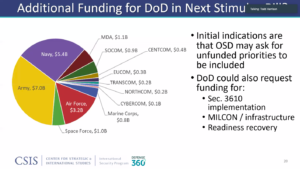
Todd Harrison
WASHINGTON: With the federal deficit expected to balloon to over $4 trillion in fiscal 2020 due to spending to pump the economy in the face of the COVID-19 coronavirus pandemic, downward pressure on the US defense budget is inevitable, several experts believe.
“I think the budget comes down sooner rather than later,” Mackenzie Eaglen, resident fellow at the American Enterprise Institute, said bluntly in a webinar today.
The best-case scenario is for flat defense budgets for the foreseeable future, but if history is a guide, the smart money is on defense budget cuts, explained Todd Harrison, DoD budget guru at the Center for Strategic and International Security (CSIS).
“What has historically happened is, when Congress’s fiscal conservatives come out and get serious about reducing the debt, reducing spending defense is almost always part of what they come up with for a solution,” he said. “So, we could be looking at a deficit-driven defense drawdown coming. … At least history would suggest that that is a real possibility.”
Indeed, even as Congress is pulling out all the stops trying to assist DoD and the defense industrial base to weather the COVID-19 coronavirus pandemic, DoD already is being eyed as the future deficit bill-payer, Eaglen told the webinar. “DoD is at the top of the list,” she said.
Eaglen added that, at a more macro-level, the budget crunch could force DoD to re-look the goals of the 2018 National Defense Strategy (NDS) with an eye to downsizing.
“There’s going to be an impact across the board,” she said. “There probably will be a total relook — at even the NDS fundamentals, and what mission is going to have to go — in response to this.”
Harrison noted that already DoD has been looking at flat budgets through 2021, which has caused it to have to take some risks as it tries to juggle divesting in high-maintenance legacy systems with investing in future programs while maintaining readiness to handle a possible peer conflict with Russia and/or China.
“Just to divest legacy systems and invest in new ones and try to maintain, or slightly grow, force structure, DoD was already saying that it would need three to five percent real growth each year in the defense budget, going forward, just to fully execute that,” he said.
This means that DoD leadership is going to face even more difficult decisions in the future, Harrison explained. “Now we’re looking at an environment where the budget might be flat at the best case or trending down over time. Something’s gonna have to give. And so, if DoD really wants to protect these key modernization programs, not only is it going to have to divest legacy systems, it’s going to have to divest them faster, and it’s going to have to make some reductions in force structure that’s going to incur risk.”
More immediately, Harrison said, as Congress moves over the next few months to pass a fourth, or even a fifth, economic stimulus package DoD already is signaling that it hopes to see a number of its “unfunded requirements” stuffed into those bills.
“DoD is saying: ‘hey, if you want to fund more things for DoD to help stimulate the economy, and help the defense industry, well, here’s a list you already have that you can pick from.”
DoD’s unfunded priorities list — the annual wish list of programs it would like to fund if only there was more money in the top-line — for 2021 includes a total of $35.9 billion for programs across the military services and the combatant commands.
The Pentagon might also petition Congress for greater authority to use operations and maintenance funds appropriated but not spent due to work slowdowns to short up programs facing cost overruns because DoD paid contractors for work supposed to be done, but not actually done, while employees are home-bound due to the pandemic, Harrison said.
“DoD has implemented the CARES Act implementation, saying that they would pay for paid leave for employees of defense industry firms that are unable to report to work. And so that cost is covered,” Andrew Hunter, who works on defense industrial base issues at CSIS, explained. “Those folks aren’t necessarily going to be laid off; they will be kept on the payroll and paid. And again, that will create some costs down the road to then pay those folks to do the actual work that they’re originally scheduled to do.”
 Most of the nearly $10.5 billion in the CARES Act, signed by President Donald Trump on March 27 to help DoD protect itself from the impacts of the pandemic goes into O&M accounts, according to CSIS. That said, some $1 billion goes to procurement funding, with an eye on health-related equipment. Further, it includes some $1.5 billion in the Defense Working Capital Fund, which allows DoD to make investments in things like depot maintenance, transportation and supply management in the near term and recoup the costs through future year pricing deals.
Most of the nearly $10.5 billion in the CARES Act, signed by President Donald Trump on March 27 to help DoD protect itself from the impacts of the pandemic goes into O&M accounts, according to CSIS. That said, some $1 billion goes to procurement funding, with an eye on health-related equipment. Further, it includes some $1.5 billion in the Defense Working Capital Fund, which allows DoD to make investments in things like depot maintenance, transportation and supply management in the near term and recoup the costs through future year pricing deals.
However, the bill grants DoD a good deal of flexibility to move money around — with the exception of banning any funding for Trump’s southern border wall construction.
Sullivan: Defense industry ‘still underestimating’ global need for munitions
National Security Advisor Jake Sullivan said that there are “no plans” for another Ukraine supplemental at this point.


























